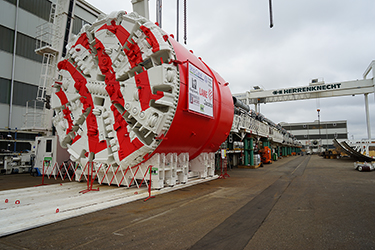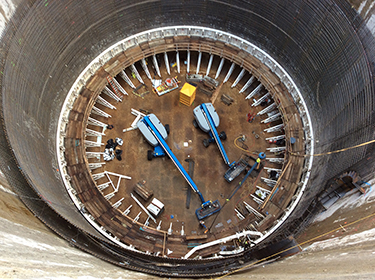|
Subscribe / Renew |
|
|
Contact Us |
|
| ► Subscribe to our Free Weekly Newsletter | |
| home | Welcome, sign in or click here to subscribe. | login |
Construction
| |
January 29, 2021
New tunneling machine to be star of $570M CSO tunnel project
Journal Construction Editor
Seattle, meet the latest German import: it weighs 450 tons and travels about 58 feet per day. BMW? Mercedes? Audi? Nope, it's a Herrenknecht.
The Herrenknecht tunnel boring machine arrived partially disassembled at the Port of Tacoma earlier this month and will be making nighttime trips in four or five pieces to Seattle, where it will be reassembled and put to work digging a 2.7-mile tunnel along the Lake Washington Ship Canal.
The machine is a key piece of the $570 million project designed to contain 29.6 million gallons of combined sewer overflows in the tunnel that otherwise would end up in the canal, Salmon Bay and Lake Union through seven outfalls. Those outfalls average 104 CSO discharges each year, amounting to over 75 million gallons of mixed raw sewage and stormwater. This project will limit that to less than one discharge per outfall, yearly.
Seattle Public Utilities and King County Department of Natural Resources are jointly developing the project.
SPU project executive Keith Ward said the system needs to be operating by the end of 2025 in order to meet federal requirements. He said the project is divided into four construction contracts and the first, preparing the machine's launch site in Ballard, was finished in 2019 by Redside Construction under a $10 million contract.
A $255 million contract was awarded in summer 2019 to Lane Construction Co. to build the main tunnel, which will be 18 feet, 10 inches in diameter; and a second 600-foot-long, 8-foot-diameter tunnel that will run under the ship canal between Queen Anne and Fremont. The smaller tunnel will be built using a microtunneling technique that involves remote operation from the surface.
Ward said the larger machine is the same size as what most contractors worldwide use to build light rail tunnels. He called it the Toyota Corolla of tunneling machines, whereas Bertha, the 57.5-foot-diameter machine that built the SR 99 waterfront tunnel in Seattle, would be a Ferrari.
SPU and King County haven't named the new machine. Ward said they plan to have a naming contest in March.
Herrenknecht started building the machine in May in Germany and tested its cutterhead assembly and 500 feet of trailing gear before partially disassembling it for an ocean voyage that began in Rotterdam and included a trip through the Panama Canal. The pandemic prevented local staff from traveling to Germany for inspections, so Herrenknecht sent them ongoing videos of the process and SPU hired an expert in Germany as an agent.
Ward said the machine should be reassembled and lowered in large pieces in April in a dropshaft that was dug in Ballard. It will start tunneling as early as mid-June and take about 14 months to complete its path to Wallingford. Lane will stop at two locations to inspect the machine for wear. Crews will tunnel horizontally from nearby dropshafts — in Fremont and east Ballard — to reach the machine for inspection.
Ward said they will build a 12 million-gallon-per-day pump station in 2023 in the Ballard launch shaft. That hard-bid contract is expected to let in 2022 and will include trenchless installation of 2,000 feet of 60-inch-diameter pipe through Ballard. An early estimate is $80 million.
Another contract will be let in 2022 that includes a 650-foot pipeline consisting of 36- to 42-inch-diameter pipes designed by SPU staff. It's estimated at $8 million.
Ward said the city is tracking to pay about 65% of the project, with the county picking up the rest. He said the project is on schedule and budget. In 2018, planners pegged the cost at $570 million with a 65% confidence level (meaning there is a 65% chance the final cost will be at or below budget).
Ward said SPU has at least $284 million in state and federal low-interest loans, which are expected to save ratepayers $82 million. The county has low-interest loans for $162 million, estimated to save about $51 million in financing costs.
Jacobs is the construction management consultant. The rest of the team includes McMillen Jacobs Associates (no affiliation) of Seattle as design engineer for the storage tunnel and pump station. Kennedy Jenks is the designer of the Ballard conveyance pipeline.
Ward said a lot of the project team came from Sound Transit's North Link light rail project.
Benjamin Minnick can be
reached by email or by phone
at (206) 622-8272.




